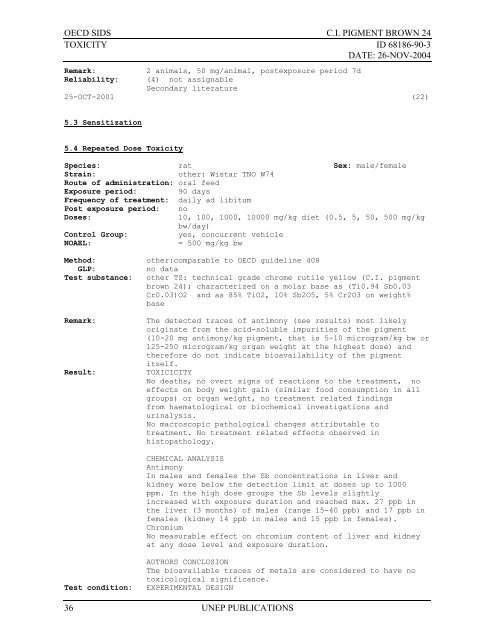C.I. Pigment Brown 24 CAS N°: 68186-90-3
C.I. Pigment Brown 24 CAS N°: 68186-90-3
C.I. Pigment Brown 24 CAS N°: 68186-90-3
You also want an ePaper? Increase the reach of your titles
YUMPU automatically turns print PDFs into web optimized ePapers that Google loves.
OECD SIDS C.I. PIGMENT BROWN <strong>24</strong><br />
TOXICITY ID <strong>68186</strong>-<strong>90</strong>-3<br />
DATE: 26-NOV-2004<br />
Remark:<br />
2 animals, 50 mg/animal, postexposure period 7d<br />
Reliability: (4) not assignable<br />
Secondary literature<br />
25-OCT-2001 (22)<br />
5.3 Sensitization<br />
5.4 Repeated Dose Toxicity<br />
Species: rat Sex: male/female<br />
Strain:<br />
other: Wistar TNO W74<br />
Route of administration: oral feed<br />
Exposure period:<br />
<strong>90</strong> days<br />
Frequency of treatment: daily ad libitum<br />
Post exposure period: no<br />
Doses:<br />
10, 100, 1000, 10000 mg/kg diet (0.5, 5, 50, 500 mg/kg<br />
bw/day)<br />
Control Group:<br />
yes, concurrent vehicle<br />
NOAEL:<br />
= 500 mg/kg bw<br />
Method: other:comparable to OECD guideline 408<br />
GLP:<br />
no data<br />
Test substance: other TS: technical grade chrome rutile yellow (C.I. pigment<br />
brown <strong>24</strong>); characterized on a molar base as (Ti0.94 Sb0.03<br />
Cr0.03)O2 and as 85% TiO2, 10% Sb2O5, 5% Cr2O3 on weight%<br />
base<br />
Remark:<br />
Result:<br />
The detected traces of antimony (see results) most likely<br />
originate from the acid-soluble impurities of the pigment<br />
(10-20 mg antimony/kg pigment, that is 5-10 microgram/kg bw or<br />
125-250 microgram/kg organ weight at the highest dose) and<br />
therefore do not indicate bioavailability of the pigment<br />
itself.<br />
TOXICICITY<br />
No deaths, no overt signs of reactions to the treatment, no<br />
effects on body weight gain (similar food consumption in all<br />
groups) or organ weight, no treatment related findings<br />
from haematological or biochemical investigations and<br />
urinalysis.<br />
No macroscopic pathological changes attributable to<br />
treatment. No treatment related effects observed in<br />
histopathology.<br />
CHEMICAL ANALYSIS<br />
Antimony<br />
In males and females the Sb concentrations in liver and<br />
kidney were below the detection limit at doses up to 1000<br />
ppm. In the high dose groups the Sb levels slightly<br />
increased with exposure duration and reached max. 27 ppb in<br />
the liver (3 months) of males (range 15-40 ppb) and 17 ppb in<br />
females (kidney 14 ppb in males and 15 ppb in females).<br />
Chromium<br />
No measurable effect on chromium content of liver and kidney<br />
at any dose level and exposure duration.<br />
Test condition:<br />
36<br />
AUTHORS CONCLUSION<br />
The bioavailable traces of metals are considered to have no<br />
toxicological significance.<br />
EXPERIMENTAL DESIGN<br />
UNEP PUBLICATIONS

















